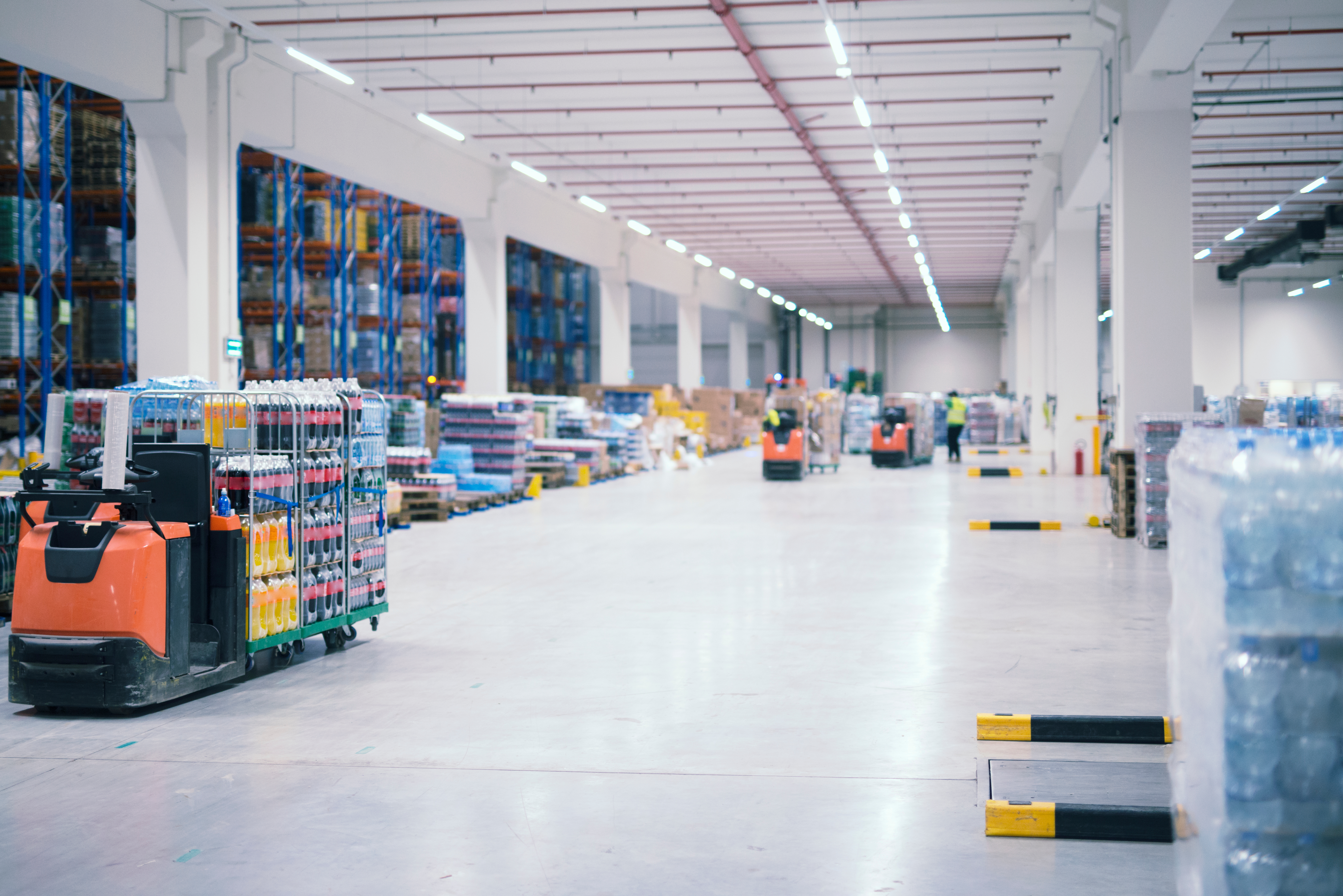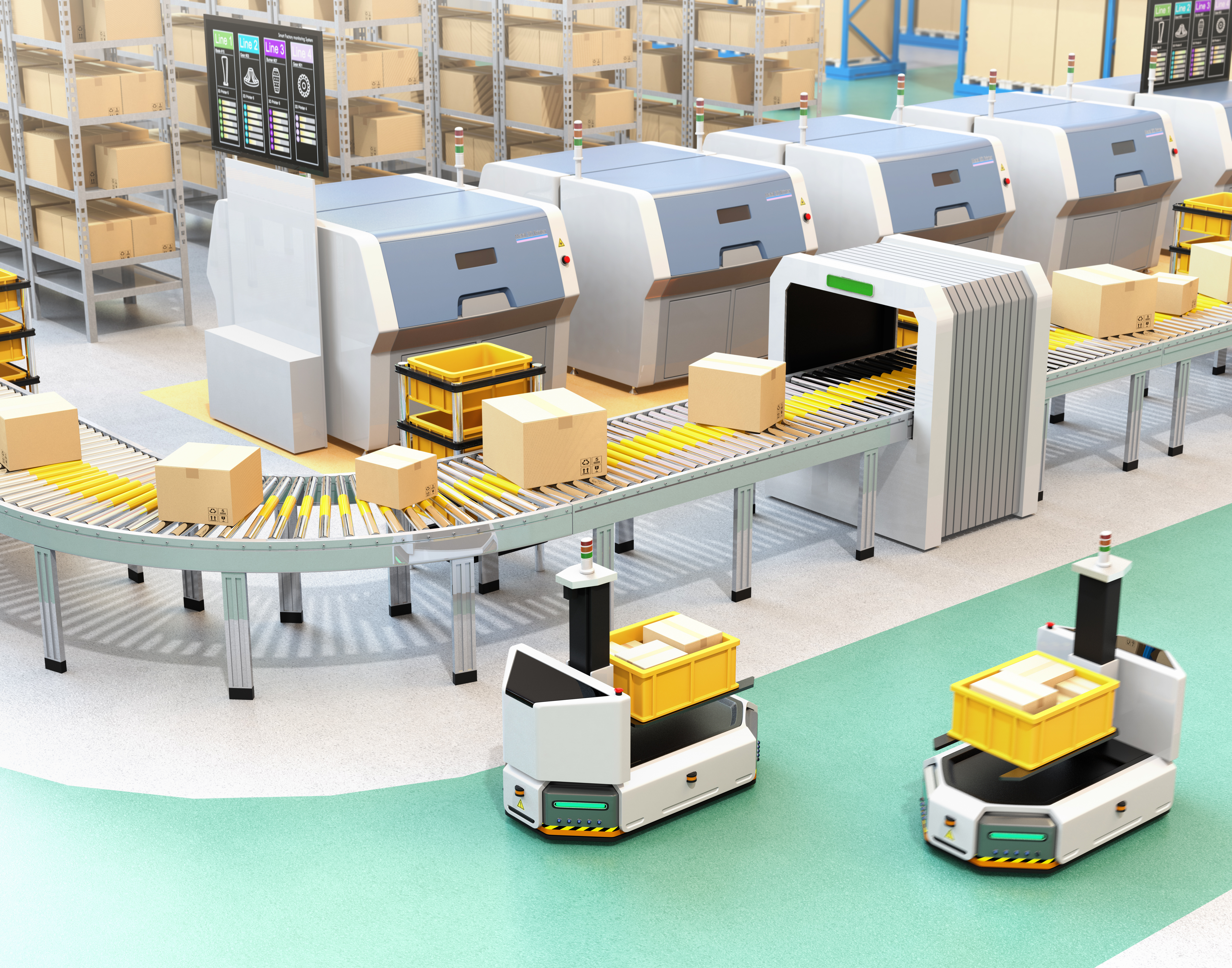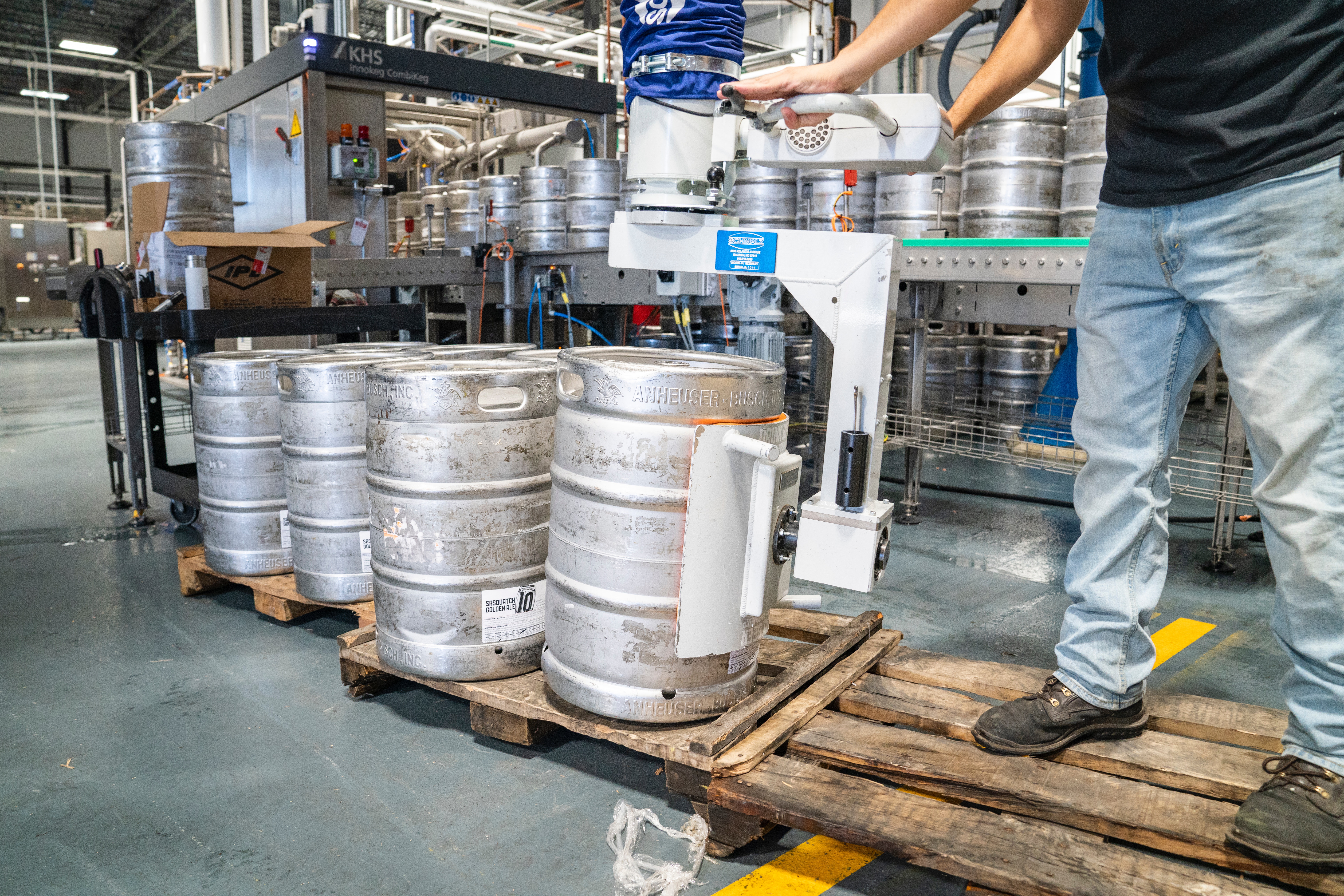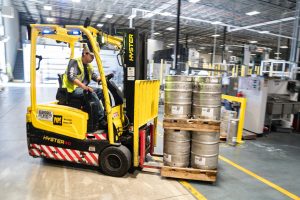
by leanmaterialhandling | Nov 3, 2020 | Factory, Intra-logistics, Lean Manufacturing, Lean Production, Material Handling, Warehousing
Kaizen is a Japanese business philosophy that emphasizes continuous improvement and forms the basis of modern manufacturing and supply chains, among other systems across the world.
The Kaizen philosophy asserts that organizational improvements are a result of small, incremental improvements on an almost daily basis, and require the contribution of all employees at all levels, from CEOs to managers to field staff.
What Does Kaizen Mean?
The word ‘Kaizen’ is derived from 2 words – Kai (change) and Zen (better). Together, the word Kaizen translates to ‘change for better’. It loosely translates to the word ‘improvement’.
However, Kaizen is more than just a word; it’s a business philosophy. It strongly endorses continuous improvement across the organization on a routine basis as the driving force of massive improvements in productivity, efficiency, employee satisfaction, customer satisfaction, elimination of waste, and other aspects of organizational performance.
Why Small Changes?
The Kaizen philosophy urges that every employee within an organization has a stake in its success, and therefore, they all should strive to make improvements routinely at all times. The changes need not necessarily be slow. Also, “small” does not mean insignificant. The Kaizen philosophy recognizes that small changes each day can accumulate together to create massive improvements in the future.
Why is Kaizen Important?
Kaizen is more than an abstract philosophy on self-improvement and continuous improvement. It is a time-tested and proven business philosophy that was developed in Japan to bring revolutionary improvements to the country’s manufacturing industry and supply chains.
Traditionally, Kaizen focuses on 5 guiding principles, which are known as Five S, as described below:
1. “Seiri” Means “Sort Out”
The Seiri principle urges employees to organize their tasks and prioritize them. The tasks must be sorted into different groups and labeled ‘Necessary’, ‘Critical’, ‘Most Important’, ‘Useless’, and so on. Throw away everything useless.
2. “Seition” Means “Set in Order”
Seition is all about efficiency. Reduce wastage of time and energy by organizing everything in a manner that makes it easy to retrieve and use when required.
3. “Seiso” Means “Shine”
Seiso is all about cleaning the workplace and decluttering it. With a “everyone is a janitor” principle, Seiso inspires employees to maintain a clean work area that makes a good impression and, more importantly, keeps the workplace safe, lean, and free from errors.
4. “Seiketsu” Means “Standardize”
Seiketsu is the standardization of the processes involved in Seiri, Seition, and Seiso. The establishment of standard processes and schedules for executing Seiri, Seition, and Seiso routinely ensure that they are done promptly.
5. “Shitsuke” Means “Self-discipline”
Shitsuke is about developing the processes that will enable an employee to execute the other four S, without external stimulus. In other words, it is about inculcating a proactive approach towards self-improvement.
Final Thoughts
As may be evident by now, Kaizen focuses on self-improvement as the path towards organizational improvement. Small but consistent positive changes in oneself and organizational activities are critical to producing paradigm shifts in organizational effectiveness and efficiency.

by Lean Material Handling | Nov 14, 2019 | Factory, Intra-logistics, Lean Manufacturing, Lean Production, Material Handling
Industries require top of the range machines for efficiency and effectiveness purposes. On that account, material handling systems come in handy to deliver fantastic results. They entail equipment that can aid in the mobilization of loads within an area. Thus, they can pick and move products from one place to another seamlessly. The systems primarily operate perfectly due to top-notch technology. They include appliances, tools, vehicles and storage units alike. Well, let’s unearth the key elements around the material handling systems.
Types
Material handling systems fall under four main categories as follows;
-
Storage equipment
-
Industrial trucks
-
Engineered systems
-
Bulk handling equipment
Storage Equipment
It is the equipment that holds materials waiting to be moved to another location for use. Alternatively, it stores products that have already been transported. One vital feature in this kind is that they are not automatic. Depending on the sector, the handling systems are normally spacious. Thus, it allows the stock to be in great condition without any damages. It also makes the items presentable and neat at the end of the production process. In this collection, you will find essential machines such as shelving, sliding racks, and pallet racks. In addition to that, there are stacking frames, push-back racks, and drive-through racks as well.
They are trucks that aid in transportation in various industries. Industrial trucks have different specs depending on their designs. They can be large or small vehicles that can be operated by hand. Most of them are automated to make work more straightforward and painless. The manual trucks are also a form of storage when the items need to be moved after some time. They include pallet trucks that function primarily as mobility tools. AGVs are part of industrial trucks that are utterly powered by other devices. What’s more, pallet jacks, order pickers, side-loaders, and walking stackers are in the group.
Engineered Systems
The material handling systems are also automated to suit the manufacturing process. They come as a complete package with shelves, aisles, and racks. In terms of performance, they are practical as they entail transportation and storage. Furthermore, some machines fully utilize the work of a computer. On the flip side, others will need manual guidance by a small margin. The gadgets have unique characteristics of automatic storage plus retrieval system. Noteworthy examples are conveyor systems, AGVs, and robotics delivery systems.
Bulk Handling Equipment
It handles goods such as food, liquids, beverages, metals, and minerals. The products are in large quantities as the name bulk implies. Essentially, the equipment is utilized for mobility reasons. It transports the loose materials for one pint to another with the utmost safety. The direction it moves is both vertical and horizontal using different bulk handling equipment. The conveyor belt goes sideways while the elevators transport upwards. Hoppers and drummers help to filter out the loose matter for packaging. Under this type, stackers, reclaimers, silos, grain, and bucket elevators are present. The appliances work complementarily to make the procedure triumphant and undemanding.

by Lean Material Handling | Nov 14, 2019 | Factory, Intra-logistics, Lean Manufacturing, Lean Production, Material Handling, Six Sigma
Tugger carts are equipment used to transport materials in various industries. The carts have a towable specification and can also operate manually. Industrial tugger carts form a train when they move goods in bulk. It is commonly known as the tugger train that involves a chain of carts. Their effectiveness is out of this world since, within a short time, one can complete tasks. Workers can move loads painlessly from one location to another. In addition to that, they are used to handle materials in a facility.
Specifications
Industrial tugger carts come in different dimensions or sizes that meet the clients’ needs. The carts are crafted from polyurethane casters so that the noise level is minimal. In addition to that, it guarantees longevity due to the top of the line material. Some carts also come with connection capacities. This way, if you need to move all of them at once, it is possible. The highlight of the feature is that you can transport items faster.
What’s more, the direction is flexible since the cart can move to the right and left with ease. It works ideally when you need to relocate bulky products in a safe mode. Maneuvering through the different paths is seamless with a tugger cart due to its versatility. Another important characteristic is the battery life depending on the machine. It lasts incredibly for hours without the need to recharges the batteries.
Benefits
The carts bring bountiful benefits to the table for all users across the various fields. With the arrays of stipulations, they have countless upper sides. Have a look at the advantages of using a tugger cart.
Safety
Industrial tugger carts have safety stop switches as part of the package. In that case, you can press the switch to avert any injury or damages. You rest assured that with the feature, you will get high safety standards at the company. It comes in handy since any manufacturing process is prone to accidents. To be on the safe side, the switch is definitely essential.
Speed
It is of the essence that tugger carts provide the quickest mobility to the industries. The products come with an awesome speed of about 0-3 mph. For this reason, they can move forward and backward at a fast pace. It means that the operator can have utter control of the device at all times. Furthermore, one can move several items making the procedure time-effective.
Dual Use
Bespoke tugger carts are usable for both outdoors and indoors purposes. Therefore, you can move the materials from the warehouse to an outside location comfortably. They can withstand different terrain due to its world-class design. If the area is sloppy, the cart can move without any hustle. The heavy-duty material is there is to safeguard it from toppling over.
Flexibility
As aforementioned, industrial tugger carts are highly flexible in mobility. Thus, if it operates manually you will not struggle pulling it. The machine comes with a turning radius that is almost zero. Navigating through the pathways is not a daunting task at all.

by Lean Material Handling | Nov 14, 2019 | Lean Manufacturing, Lean Production, Material Handling
Industrial robots are an automation technology that has changed the face of manufacturing a great deal. In the old days, even the most dangerous, laborious and repetitive tasks were all done by hand by people. Industrial robots have changed all that, bringing with them consistent precision, accuracy, flexibility, and maximum productivity. Industrial robots are programmed to perform laborious tasks as well as those that are deemed dangerous for humans. This automated technology is exponentially being used in various industries and applications. Industrial robots come in a wide range of models, and their distinguishing characteristics include payload capacity, reach distance, and other features.
Advantages of industrial robots
Increased productivity
Industrial robots are programmed to perform repetitive tasks with greater consistency and better quality. Their output is predictable and precise, unlike workers who can be inconsistent at times. They are almost 100% accurate, resulting in higher quality products with greater consistency. Additionally, they do not need breaks, shift changes, or any disruptions. They attain close to 100% uptime; hence, they can work round-the-clock leading to dramatic increase in production levels, which in turn increases profitability. Moreover, they are continuously updated to maximize their efficiency.
Increased efficiency
Industrial robots are designed to complete tasks faster and at a higher accuracy level. This makes them effective at handling tasks which previously took a lot of time and resources. Unlike humans, industrial robots do not experience fatigue. Due to their higher accuracy levels, they can be utilized in the production of high-quality products, which must meet specific standards of quality. With the optimized production efficiency of industrial robots, companies can incorporate them into their production to maximize efficiency.
Improved workplace safety
Safety is one of the obvious benefits of utilizing industrial robots. Manufacturing processes often place workers at a high risk of physical injury. Talk of the heavy objects, exposure to hazardous chemicals, back-breaking labor, and poor air quality. Industrial robots limit human work in dangerous environments such as in hot temperature environments and where strong chemicals are used. The robots are also used to perform tasks that are highly laborious and repetitive. Overall, industrial robots improve working conditions and workplace safety.
Reduce costs
Using industrial robots in manufacturing is cheaper than employing human workers. Unlike humans, who are paid annual salaries and employment benefits, the only costs associated with robots are maintenance and energy costs. Besides, industrial robots achieve higher production with a minimum number of workers. Therefore, they allow manufacturers to save money.
Reduces production time
Industrial robots do not take breaks, get tired, or lose work focus like humans. With their repeatability and accuracy, they speed up the production time to maximize output. They also use precise amounts of raw materials to reduce waste.
Generally, industrial robots come with many amazing benefits for manufacturers. They optimize the entire production process making it more profitable and efficient. Besides, they’ve become smarter and cheaper, meaning manufacturers can easily incorporate them in their production process and reap the benefits. Industrial robots are an absolute necessity in the competitive manufacturing industry.

by Lean Material Handling | Nov 14, 2019 | Factory, Intra-logistics, Lean Manufacturing, Lean Production, Material Handling
Industrial automation is the use of automated control systems and devices such as robotics and computer software to control industrial processes and machinery, resulting in automatic functioning of industrial processes without the need for significant human intervention. Industrial automation is implemented to make industrial production processes simpler and efficient. Furthermore, it helps to save on labor costs, eliminate the possibility of human error, save time, create a safer working environment, and achieve higher efficiency.
Industrial automation has seamlessly integrated into almost every industry, with automated systems doing everything from manufacturing to packaging, and controlling HVAC systems.
Industrial automation involves the use of a wide range of tools that incorporate different devices and systems that impact on different aspects of the assembling or production process. Some of the industrial automation tools include; PLC’s, PC’s, machine drivers, sensors & actuators, human-machine interface systems, robotics, and communication modules.
Types of industrial automation systems
Fixed automation system – This system is designed to perform fixed and repetitive tasks, and there are rarely any changes made to the operations. This system is commonly employed in mass production systems.
Programmable automation system – In this system, assembling or processing operations can be modified using electronic controls. Reconfiguring this system takes a considerable amount of time and a longer setup, and it’s usually used in batch process production.
Flexible automation system- A flexible system is controlled by computers and offers great flexibility for making changes to the assembling or processing operations. These changes can be implemented quickly through commands. This system is best suited for production processes where the product varies frequently.
Advantages of Industrial Automation
Improved efficiency
Automated systems work faster and harder than humans, and can be deployed for 24 hours in a day 7 days in a week and 365 days a year.
Automation improves quality
Industrial automation cuts out the factor of human error to guarantee products of a higher and consistent quality.
High flexibility
Introducing new production capabilities in a production line results in many training hours for operators. However, automated systems can be programmed to do any task. New production capabilities can be instantly integrated into an assembly line. This allows manufacturers to save money and time on training.
Improved safety
Automated systems remove employees from dangerous work environments such as extreme temperatures, exposure to hazardous chemicals, poor air quality, heavy objects, and other dangerous working conditions.
Higher information accuracy
Manufacturers require production-related data to make informed decisions. Manual collection of data can be costly and prone to human errors. Industrial automation allows for automated and accurate data collection using sensors and devices.
Reduces costs
Industrial automation significantly reduces operating costs. Unlike human operators, an automated system does not require things like paid leave, holidays’ healthcare cover or any employee benefits. Although the initial costs may be high, subsequent costs are lower compared to employed human workers. Moreover, industrial automation achieves higher efficiency with fewer workers which means a higher return on investment.
Industrial automation has truly revolutionized the manufacturing sector in many ways. Manufacturing is certainly a tedious process without automation. Therefore, manufacturers need to adopt industrial automation to streamline production and boost profit margins.

by Lean Material Handling | Nov 14, 2019 | Lean Manufacturing, Lean Production, Material Handling
AGVs are vehicles that operate with the aid of automatic technological systems. They are prominent in the industrial realm since they speed up work. What’s more, the AGVs are the safest to use in the work area. Their usage revolves around relocating materials to other places effectively. On that account, the transportation process is seamless due to the automated machines. The equipment is custom-made to suit every ounce of need for various manufacturers. For this reason, they are widely used in healthcare, communications, cross-docking, warehouses, and textiles sectors. So, how do AGVs work? Let’s delve right into their performance, bearing in mind the extensive benefits.
Methods
AGVS have arrays of techniques that power their movement with sheer simplicity. Have a look at the different ways that make them work.
Wires
For starters, the machines are loaded with wires that assist with the navigation. Usually, the wires are underneath the AGVs to ensure that motion is effortless. Therefore, the wires are linked to sensors that perform impeccably. In addition to that, there are radio frequencies located between the sensors and the wires. They are the key secret behind the movement of the guided vehicles.
Lasers
Moreover, lasers are another convenient way that assists the mobilization of AGVs. Here, two piloting varieties are the ultimate workable solutions. They are Pulsed Laser and Modulated Laser that have virtually endless benefits. Thus, the vehicles have a laser emitter as part of the fitting. Similarly, retro-reflective gadgets collaborate with the lasers to mobilize the apparatus.
Computers
With the digitalization era, AGVs incorporate the use of computers to move materials. They function by controlling how the vehicles maneuver from one section to another. Hence, the use of transponders is eminently common since they are utterly practical. Additionally, the tools use a gyroscope to guide AGVs to the optimum direction. It also helps in re-directing the equipment in case it misses the spot.
The CAD software is notable since it helps the engineer to steer the machines smoothly. It indicates the available paths and the final destination of the load. Traffic controllers also complement in the task completion alike.
Directional Tapes
They are also known as guide tapes since they are productive in the AGVs. The stand out specification entails the utilization of conspicuous magnetic tapes. Their viability surpasses wires because they are removable when the route changes. Further, re-alignment is another option and it means directional tapes are versatile. The automated vehicle cannot function without the proper use of guide tapes. They form a pivotal part of the machine for it to make progress.
Hauling
Ultimately, AGVs operate by attaching them to trailers that can haul the container. It can be in the form of cargo or other products as per the facility. The hauling capability also differs and can range from 20, 40 to 45 inches. The highlight is that the machine is highly flexible. It takes any direction, for instance, backward, sideways and forwards. Hauling is quite an essential characteristic that makes an AGV work incredibly.

by Lean Material Handling | Dec 9, 2018 | Lean Production
What would it be like if one day we woke up and there was nothing for us to do or nothing for us to anticipate? How annoying is it that thought let alone if the situation comes to reality? Fortunately, that is not and never the case.
The world around us is continuously evolving from both the small and significant innovations that are happening in every corner of the world. There is always some part of the world that is continually working, thinking, planning, creating something new or redefining some of the old creations. This is what makes us tick and look forward to a better tomorrow. For this same reason, subjects like Project Manufacturing are gaining a lot of attention these days.
What is Project Manufacturing?
Project manufacturing is a large-scale industrial operation process that is mainly carried out to design and produce big, highly specialized, and costly products such as ships, aircraft, submarines, defense systems, customized consumer products such as automobiles, homes, and others.
However, one product manufacturing process is significantly different from the other, as every process is highly unique. Nevertheless, project manufacturing processes are quite flexible regarding operations, mainly because every product that each manufacturing project manufactures is substantially different from the other. Thus, with large project sizes of every project, the high expenses associated with each project, and the high degree of customization that is applied to each project, makes project manufacturing relatively a long duration process for each project to attain its completion phase.
Highlighting Features of Project Manufacturing
- It produces similar products in large numbers but in a unique manner. For instance, vehicle manufacturers produce similar automobile parts in larger quantities but ensuring that it all fits different vehicle requirements in some way or the other.
- It exploits the principle of using “common manufacturing requirements” to increase the efficiency rate. For instance, if two or more customized projects require the same manufacturing components, then these are produced at the same time but in larger quantities to save time and resources.
- It allows for customizations to produce unique combinations of products and services. For instance, home manufacturers will go out of business if they construct the same models of houses for all its clients. Therefore, they need to ensure that modifications are made, and customizations are accommodated as per client preference.
- Unique requirements are treated as a separate project to improve overall efficiency. For instance, manufacturing ships for defense purposes and those for cruise purposes need to be considered as two different projects rather than as one single project, as both these have different requirements.
Major Problems that Project Manufacturing Faces
No doubt, it has been concluded that Project Manufacturing is indeed a large-scale operation and like most large-scale projects, Project Manufacturing too suffers from its share of problems. Of the many issues out there, here is a look at the three major issues that most project manufacturing projects face during its project completion.
- Lack of Project Ownership & Micromanagement: The fundamental problem that most large-scale projects face is that the plan lacks proper control systems as it progresses forward, thereby going through a series of handlers who adopt micromanagement practices, which bring about a negative working environment. This in turn also results in laborers who steer away from responsibilities, and as a result, projects lose momentum through its course.
- Lack of Information: Information is knowledge. Hence, there must a proper flow of information through every channel. For instance, incomplete/inadequate/inaccurate information will result in poor project delivery. Some projects fail because the production team is not provided with adequate information and as a result, production does not meet the intended Similarly, information passed on to the customer is also important, without which product handling and usage fail.
- Material Mismanagement: Another major problem that most big manufacturers face is the problems associated with material handling and storing. While some projects experience material shortages, others face material surplus issues, both of which create additional problems. For instance, material shortages will lead to production halts and thus result in loss of revenue. On the other hand, an excessive stock is primarily viewed as locked capital, which again if not appropriately managed or diverted to other needy operations will result in reduced profits for the Company.
Solutions to Conquer the Three P’s
Problems are never-ending in any field and needless to say, a new project throws more issues than you anticipate or can handle. It is easy to list out problems, but true talent surfaces only when the root cause of the problem is identified, and the best solution to the problem is devised in the most cost-effective and least time-consuming manner. Thus, here are the best solutions that may be employed to the above the three problem statements.
- Proper Ownership: All projects, irrespective of its size and investment, must ensure appropriate management right from the start to delivery. This is crucial to provide quality, deadlines, and budgets are met within the set parameters. For this, every project must necessarily have a Project Lead/Manager who will take full ownership of the project and whose primary function is to oversee the different stages of project transformation.
- Proper flow of information: Information must be well documented and passed on to the next level to ensure project management or product usage occurs at its best. Projects should never kickstart with incomplete information such as lack of drawings or insufficient labor. It is better to put such plans on hold rather than wasting money and resources. Hence, it is vital that information is passed on smoothly from project initiation to delivery and ultimately usage.
- Efficient Material Management: Companies must plan their material requirements. For this, many useful industrial practices such as the Just-in-Time (JIT) approach, Six Sigma practices, zero waste systems, or the Kanban systems can be applied in their manufacturing processes, especially while producing standard items and procuring common raw materials.
Thus, in short, Project Manufacturing can be seen as an amalgamation of the best Industrial Manufacturing processes and the most effective Project Management systems at a standard level sharing common interests of ensuring financial gains for the company as a whole.

by Lean Material Handling | Nov 9, 2018 | Material Handling
Material Handling is the process of moving goods and materials short distances within a building, factory, facility, or warehouse. Material handling includes a wide range of different types of materials, ranging from tiny boxes to large and heavy components for manufacturing. To conduct this process of material handling, there is a wide range of material handling equipment. The types of equipment range from:
-
manual
-
semi-automated
-
and automated equipment
Material handling refers to the entire process of processing, storage, as well as the control of the goods. It is used to help create “time & place utility” through handling, storage and the control of the material (Michael G. Kay, Material Handling Equipment, 2012).
According to MHI.org:
“Material handling is the movement, protection, storage and control of materials and products throughout manufacturing, warehousing, distribution, consumption, and disposal. As a process, material handling incorporates a wide range of manual, semi-automated and automated equipment and systems that support logistics and make the supply chain work. ”

The role of material handling plays is significant and has become a topic of discussion, in particular amongst manufacturing companies. Every type of product that has been manufactured or produced has been involved in a material handling sequence of some sort. Whether that be transported via forklift, or along a conveyor line. Many large manufacturing companies invest millions of dollars every year to ensure that there material handling processes and flows are up to date and efficient.
This is where the idea of lean manufacturing and six sigma have originated, as processes and ideas to eliminate inefficiencies within manufacturing processes.
Creating an efficient material handling system for a large factory, facility or warehouse isn’t an easy take to accomplish. The dynamic environment that all industries exist in today makes it very difficult to plan long term. Especially with the development of the internet and the personalization of many products it has become more and more difficult for manufacturers to keep up with the level of customization now offered to consumers.
Material handling systems are planned out to help develop best practices and methods within a facility for long-term efficient flows. There are generally ten material handling principles which have been taken and used by a majority of facilities globally. These principles have been made and have greatly helped facility managers with the productivity, customer service, and profitability of their factories.
The ten principles of material handling (according to MHI.org) are:
- Planning Principle
- Standardization Principle
- Work Principle
- Ergonomic Principle
- Unit Load Principle
- Space utilization Principle
- System Principle
- Automation Principle
- Environmental Principle
- Life Cycle Cost Principle
These principles help with the planning and processes of all material handling and are just as relevant whether the equipment is manual, semi-automated or fully automated.
While material handling of a product does not add any direct value to the customer, how efficient or inefficient a process is, can directly affect the consumers outlook on the company, product and possibly industry.

by Lean Material Handling | Oct 15, 2018 | Warehousing
Warehouse management is easy and tricky at the same time. The stakes are high, and as such, all the logistics have to be implemented the right way otherwise face the consequences. The traditional warehouse operations have combined with today’s home delivery and online shopping creating a harsh environment for warehouse operators. One of the logistics in mind here is order picking. Order picking determines the customers’ satisfaction and the warehouse’s organization. The accuracy of the process saves time and cost as well as avoiding costly inventory errors. This is easy with the automated systems that can track orders from the moment they are placed. However, there is still some warehouse that does both the manual and machine order picking hence the need to improve the process. Lucky for you, regardless of the order picking method, we have compiled some of the ways you can adjust the process, and they are;
Analyzing product velocity
If a product is fast-moving, why then is it slotted way back? The order pickers will waste a lot of time if they have to make several trips. Even in writing, it doesn’t seem logical. Analyzing product velocity will hence save time by exposing items that should be near the shipping dock for easy access thereby optimizing the process. Such a system helps the warehouse to know the inventory that is needed most as well.
Proper inventory slotting
Order picking need not be complicated and organizing inventory is the first step to ensuring accuracy. By putting similar products together, as well as most popular ones, it makes it easy to pick orders in any method. Whether you are using zone picking, batch picking or wave picking, if the inventory has been organized strategically, the error chances are significantly reduced.
What are the picking routes?
If order pickers aren’t sure where products are, they may circle back several times leading to time wastage. Establishing picking routes based on the information obtained from the slotting and product velocity analysis helps take the guesswork out and improves accuracy. This can apply to automatic order picking as they have selected the right items in the least amount of time.
Keeping inventory data
Order picking is reliant on accurate inventory data. The data should be accurate and up-to-date. It makes identifying products fast, and less stressing. Keeping updated inventory data also assists the warehouse from committing themselves to deliver items that are out of stock and adds to the visibility of other items. Also, it shines a light on inventory that isn’t being used saving the warehouse space and money.
Using error data
Optimizing warehouse operation and order picking process will require analysis of error data. This reduces the chance of ever repeating the same mistakes. It keeps the order pickers on their toes as well since this data can be used to evaluate their accuracy. However, it is difficult to eliminate order picking errors but at least this way, you can minimize mistakes that can cost the warehouse tons of resources correcting them.
Automation
Thanks to the digital era, man and machine can work together to improve the order picking process. Warehouse automation is the way to go if you want to improve your efficiency. Software and robotics are being used to control the production lines. At the same time, they can be used to advance order picking as it becomes more efficient and fast. Embracing automation has led to many warehouses fulfilling their word for quick deliveries, and there have been minimal errors.
When customers get the right delivery, the credibility of your warehouse is rated highly. Using these few ways to improve order picking will help achieve this.

by Lean Material Handling | Aug 9, 2018 | Warehousing
Timely deliveries and meeting customers’ demands are important in helping maximize the supply chain processes. It all starts with how well you manage your warehouse operations. A poor warehouse management system will lead to huge economic losses. This is not what we are after. So we have to manage all aspects of the warehouse to ensure that at each level, we reduce cost and improve the warehouse’s efficiency.
Also, today’s rise in e-commerce demands that the warehouse is organized to fulfill customers needs. The increase in e-commerce creates pressure to the warehouse as customers expect quick home deliveries. Therefore, warehouses have to do all they can not to fail their customers otherwise lose their business. From processing the orders to loading them in trucks, their efficiency will be vital in avoiding mistakes and any delays. To achieve this, we manage the labor, freight, and inventory.
Managing labor
Even though we incorporate modern technology in the warehouse, there will still be employees to take care of picking and packaging. You will need to motivate them to double their efforts with the little time they have to do their day’s work. Offering incentive pay is a guaranteed way to boost morale and improve productivity.
Also, you will need highly trained frontline managers to manage warehouse operations on the ground. Having highly trained frontline managers will require them to know the warehouse workings, the customer’s and vendors’ needs as well as other aspects of the warehouse. That said, you can hire qualified managers or offer them training. There are several resources online, and locally that will assist frontline managers to become better.
Managing freight
If not well maintained, it dramatically affects the warehouse efficiency. The terms of the agreement and laid out policies shouldn’t compromise on product packaging and timely deliveries. Consultants can help to make sure inbound and outbound freight aren’t the source of profits going down the drain. The consultant you turn to should be experienced and know the laws surrounding freight management and negotiations. The moment freight issues are taken care of; the warehouse operations can run smoothly improving warehouse efficiency.
Managing inventory
Inventory plays a significant role in supply chain management as well as warehouse efficiency. Overstocking and dead stock usually cost you more than you think. Consequently, it would be prudent to put in place measures to control inventory.
One way of doing so is using third-party fulfillment. Through the option, one can concentrate on other areas of warehouse management as the third-party fulfillment will ensure that the inventory meets the order throughput. Also, it helps increase storage hence offering more opportunities for growth.
Managing these three aspects of the warehouse should be easy especially now that technology has become part and parcel of the whole warehouse processes. Through technology, warehouse employees can be able to deliver and produce more products, and at the same time, it is easy to track your inventory to avoid cases of overstocking and overhead stock.
This is an excellent time to manage their logistics as a way of improving warehouse efficiency since they have the opportunity to use the latest software as well as modern technology to move things along. Consequently, customers will be satisfied with the fast and accurate operations following the warehouse’s services.
All in all, warehouse efficiency is the key to reducing cost and improving productivity. Therefore, the warehouse management system you opt for should be geared towards increasing efficiency. And a system that will manage the three aspects, labor, inventory and freight, is a viable one. Thus consider the above when formulating your system.














